Intel Dual-Core Mobile Ivy Bridge Launch and i5-3427U Ultrabook Review
by Jarred Walton on May 31, 2012 12:01 AM EST- Posted in
- Laptops
- CPUs
- Intel
- Ivy Bridge
- Ultrabook
Ivy Bridge Ultrabook Quick Sync and 3DMark Performance
Buying a laptop isn’t just about generic office and Internet applications, naturally. Intel (and AMD and NVIDIA) have been pushing video and image processing applications as increasingly important, in our digital Facebook/YouTube/etc. world. We’ve looked at two video transcoding applications from ArcSoft and CyberLink several times already, but let’s see how Ivy Bridge Ultrabooks rate. We’ve run a video transcode converting a 3:43 minute 1080p24 video clip taken with a Nikon D3100 camera into a 720p video and timed how long the process takes.
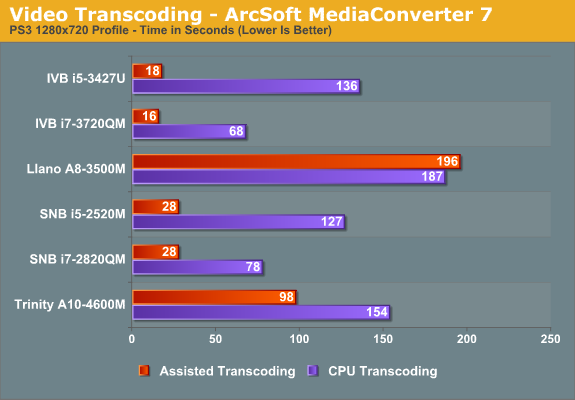
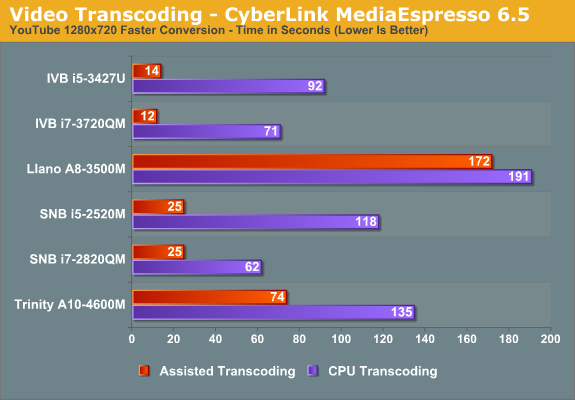
Quick Sync continues to be the undisputed champion of these two applications, beating out AMD’s accelerated transcode on Trinity by a factor of five. However, if you’re really into video transcoding and you want more control over quality, we don’t know many people who use MediaEspresso or MediaConverter. For free software, Handbrake is probably the most popular option right now, and as we showed previously, AMD has a beta OpenCL accelerated version of Handbrake that they’ve been working on where they can come very close to quad-core Ivy Bridge performance.
It remains to be seen when the public release of Handbrake will get such support, not to mention Intel and NVIDIA are going to be interested in getting the OpenCL version to run appropriately on their hardware. Still, it’s important to keep these other developments in mind. For now, the best quality transcodes still come by way of the CPU, and ULV Ivy Bridge offers better performance than AMD’s Trinity A10 in that case—never mind the standard voltage parts. We expect to see additional software companies start looking at ways to leverage OpenCL, GPUs, APUs, and Quick Sync to help with this sort of workload going forward.
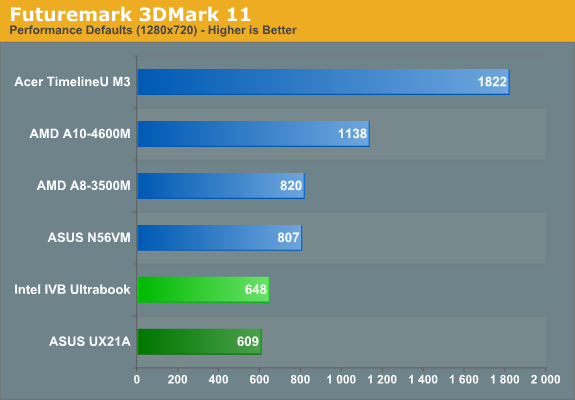
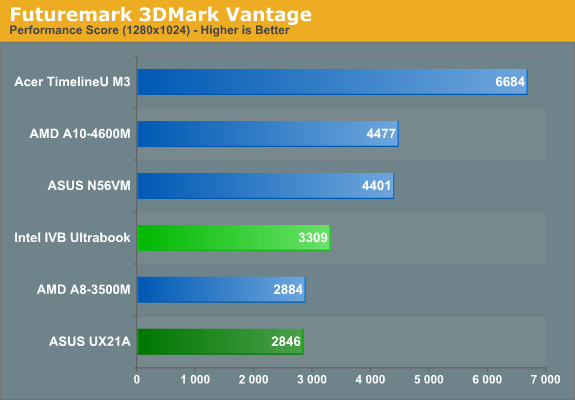
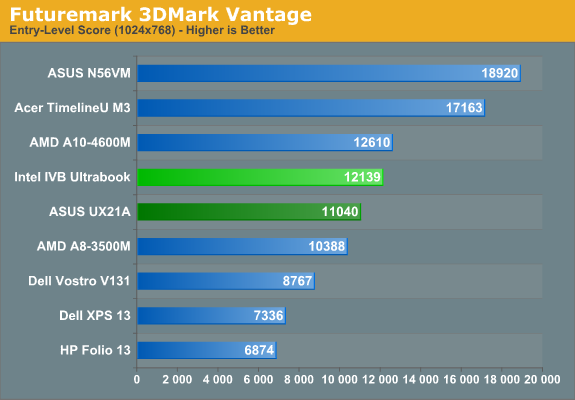
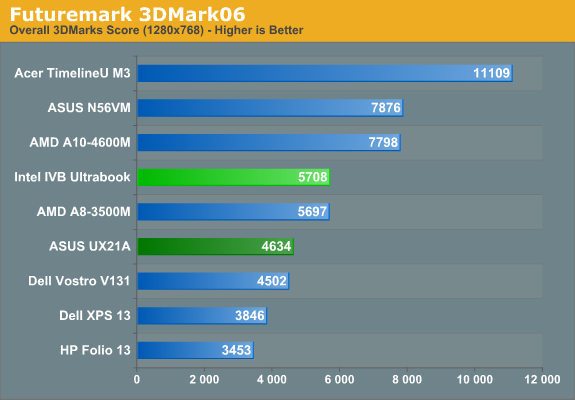
As for synthetic graphics performance, Intel has performed quite well in 3DMarks for several years now—we’d argue their 3DMark scores are often optimized far more than actual gaming performance. Still, 3DMarks are a nice way to compare across several generations of hardware, so we continue to run them on laptops. Again we see the UX21A trail the IVB ULV prototype, despite having a higher performance i7 CPU; thermal issues are the most likely cause, and the difference ranges from a rather minor 6% gap in 3DMark11 up to 23% in 3DMark06. Also interesting is that the quad-core i7-3720QM, which has a GPU that’s only clocked up to 9% higher, ends up leading the ULV IVB part by 25% (3DMark11) to as much as 33% or more! The extra—and faster—CPU cores might be a factor, but it’s also likely that the i7-3720QM is able to hit the maximum 1250MHz GPU clock far more often than the i5-3427U can hit its maximum 1150MHz clock.
Once we get beyond the Intel IGP comparisons, however, things don’t look nearly as good for ULV Ivy Bridge. Llano is around 25% faster in 3DMark11, though ULV IVB comes out ahead in the other results; Trinity on the other hand is 35-75% faster in the three main results (e.g. not counting 3DMark Vantage Entry, as that’s very low in terms of stressing the GPU). Again, the most interesting comparison is unfortunately one we can’t make yet: how will the A10-4655M 25W Trinity APU (with GPU clocks that are almost 30% lower than the 35W A10) compare with ULV IVB? We’ll have to take a wait and see approach on that one, but depending on the game it may or may not be a close matchup.










64 Comments
View All Comments
mikk - Thursday, May 31, 2012 - link
Why you don't record the frequency used in games with gpu-z? This would be interesting. And it would be also interesting to see how it performs with a disabled cpu turbo to give more headroom for the iGPU.JarredWalton - Thursday, May 31, 2012 - link
GPU-Z doesn't detect HD 3000/4000 frequency; in fact, I'm not sure anyone has a utility that correctly reports HD 4000 core clocks. If I'm wrong, please let me know as I'd love to be able to do a FRAPS run and log the iGPU clocks! If you know of one, please post and/or email me.mikk - Thursday, May 31, 2012 - link
JarredWalton: "GPU-Z doesn't detect HD 3000/4000 frequency; in fact, I'm not sure anyone has a utility that correctly reports HD 4000 core clocks. If I'm wrong, please let me know as I'd love to be able to do a FRAPS run and log the iGPU clocks! If you know of one, please post and/or email me"You are wrong, gpu-z 0.6.2 fully supports the HD4000, you can "log to file" the frequency. I have tried it myself on a Desktop HD4000. It's interesting. Due to some driver issues some games did not run with the max turbo frequency ony my Desktop 77W model. It's fixed with driver build 2752. There are several turbo steps between base 350/650 and max turbo 1150 Mhz.
JarredWalton - Thursday, May 31, 2012 - link
Going to go check now... I think I might have been running an older version (6.0?) I'll update the article when I have some details. Thanks for the heads up -- GPU-Z has failed to provide any useful information on HD 3000 for so long that I never noticed anything had changed! :-)JarredWalton - Friday, June 1, 2012 - link
I've posted a follow up article, in case you don't see it over in Pipeline:http://www.anandtech.com/show/5878/mobile-ivy-brid...
vegemeister - Wednesday, June 6, 2012 - link
CPU idle power doesn't mean much when you have to drive the backlight for a 17" screen. Smaller screens are more portable anyhow, and look better given the same resolution.sonofsanta - Thursday, May 31, 2012 - link
So are stardates always one month ahead of the real date, even if that stardate doesn't technically exist on the Gregorian calendar? ;)(I'm guessing you meant May 31...)
JarredWalton - Thursday, May 31, 2012 - link
Oh crap! And there aren't even 31 days in June! Hahahaha.... wrote that too late at night after a long day of testing/writing! But of course, actual Star Trek Stardates are never expressed with a month and year:http://en.wikipedia.org/wiki/Stardate
mschira - Thursday, May 31, 2012 - link
I am amazed how Intel professionals fail to realize that if a laptop does not have VGA out not even with a converter (note apple has VGA out with the right converter) it's useless for presentations.This may be different for other people but for me one of the most important jobs of a laptop is to run a presentation at conferences and this sort.
I have yet find a conference location where you could hook up your laptop via display port. Or even DVI. They simply don't exist.
-> no VGA = useless.
M.
JarredWalton - Thursday, May 31, 2012 - link
HDMI? I've seen plenty of HDMI projectors at least. But this is a prototype, and there will undoubtedly be Ultrabooks with VGA outputs (possibly via a converter). Anyway, Ultrabooks are a specialized market, so I don't expect most of them to target business users that need VGA outputs. Just because some people find VGA indispensable doesn't mean there aren't many others who wish the connector would just die already. It's basically just hanging around for legacy purposes, sort of like PS2 mice/keyboard connectors. In five more years I hope to be rid of all the old style connections on the majority of products (with those who absolutely need them catered to by niche products).